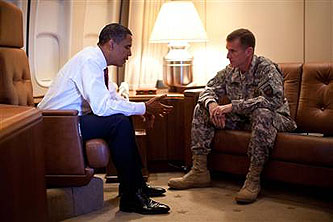 One of my frustrations with Barack Obama’s Afghanistan speech was that he didn’t explain what the strategy for deploying all those new troops was going to be. Luckily, Joe Klein asked him that question:
One of my frustrations with Barack Obama’s Afghanistan speech was that he didn’t explain what the strategy for deploying all those new troops was going to be. Luckily, Joe Klein asked him that question:
I asked him what instructions he had given the military to make the next 30,000 troops more effective than the 21,000 troops he sent last March, whose presence didn’t seem to improve the situation on the ground at all. “Look, the fact that there were increased casualties this year I think is to be expected from increased engagement by our forces.” True enough, but the NATO coalition lost ground to the Taliban this year, by Obama’s own admission. And the President could only come up with speed of deployment and a clearer sense of mission as strategic game changers. Later, when I asked him about what changes he had ordered for the training of the Afghan army and police — a frustrating proposition, so far — he deferred to his commanders in the field but said the new order of battle would include “a partnering situation, a one-to-one match between Afghan troops and U.S. troops” in combat, which “produces much stronger results.”
That’s pretty discouraging, especially since Klein says that (unsurprisingly) Obama was well briefed and obviously understood the problems at hand. But Klein’s question is clearly the central question, and surely one that Obama must have anticipated. If, after months of planning, he still couldn’t come up with a decent answer, that’s bad news.
It’s not clear that the surge in Iraq is a good model for success in Afghanistan in the first place, but to the extent that it is, you have to at least understand the model. Petraeus didn’t just send in a bunch of extra troops. He had a plan for how to use them in an inventive way. The vast bulk were sent to Baghdad, where they represented a doubling of the American presence. Separation walls were constructed all over the city. Counterinsurgency tactics were implemented up and down the line. Sunni tribes were bribed coopted into supporting us. Even at that the jury is still out on whether it will ultimately succeed, but at least it provided some additional security and gave the Maliki government a shot at making things work.
But I still haven’t heard anything like this for Afghanistan. There are plenty of people out there with ideas, but I have no idea which of those ideas Gen. McChrystal is planning to try out. Unfortunately, it looks an awful lot like Obama doesn’t know either.















